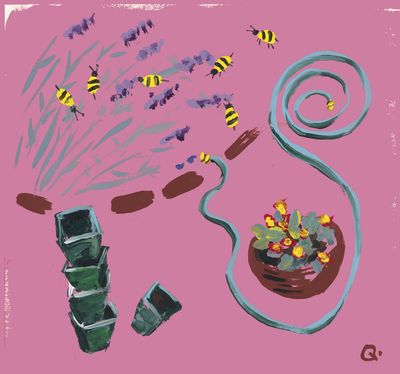In the Garden: Be a greener gardener

Gardeners do so much for the environment by planting trees and flowers, growing their own food and attracting pollinators to their gardens. In our changing world, we can always strive to become better, greener gardeners.
With this summer’s extended heat wave, relentless wildfire smoke and exceptional drought conditions, it can be easy to feel discouraged, yet there are so many positive things we can do to improve the environment.
We encounter plastics in many aspects of our lives and certainly while we’re gardening. When we go to a nursery or garden center, the plants we buy come in plastic pots of all shapes and sizes. If we start our own plants from seeds, we often purchase plastic seed-starting containers. Plastic probably won’t be eliminated in the near future, but if we reuse those pots over and over, that is a step in the right direction.
If you need to get rid of your excess pots, don’t toss them in the trash. Instead, donate them to a local gardening organization or club that holds plants sales. For example, the Friends of Manito accepts plastic pots. To learn more, go to thefriendsofmanito.org/recycle-your-pots/.
Water conservation is extremely important. If you can water your garden early in the morning, there will be less evaporation. Drip irrigation systems and soaker hoses are ideal for vegetable gardens because they put water right at the soil surface where plants can take it up. Place mulch on the soil of your beds to conserve moisture.
When it comes to our lawns, we can make a difference by changing how we maintain them. Mow less frequently because taller grass shades the roots so they’ll need less water. Go with the “grass-cycling” method by using a mulching blade on your mower and letting the clippings lie on the surface of the lawn. They will feed the grass as they break down, decreasing the need for fertilizers.
Even though green lawns look attractive, they are often referred to as “pollinator deserts” because they don’t provide food or habitat for pollinators and other beneficial insects. These creatures need our help due to loss of habitat from development of open lands. Consider decreasing the size of your lawn and planting a border of different types of flowering plants to help them out.
Another thing we can do is eliminate our use of synthetic (nonorganic) insecticides, herbicides and fertilizers. Insecticides are nonselective, meaning that in addition to killing the damaging bugs you’re trying to get rid of, they also kill predatory beneficials that would have helped control them. Herbicides remain in the soil for longer than we realize and kill the soil microorganisms that contribute so much to the health of our plants.
Synthetic fertilizers tend to be a quick fix by delivering more nutrients to plants than they are able to use. In comparison, organic fertilizers deliver more diverse nutrients in smaller quantities, which is exactly what plants need.
If your landscape took a beating from the heatwave, think about adding more drought-tolerant plants to it. They will need less care and less water once the plants become established. Consider native plants, which are well-suited to our region’s conditions. There are so many wonderful options to choose from, and fall is an ideal time to get started.
Remember to plant more trees. They take in carbon dioxide and release oxygen, which helps reduce our carbon footprint. Trees also provide shade, decreasing the need to cool down our homes during the summer months.
As we pursue our love of gardening, let’s set a good example by looking for and implementing ways to improve the environment. Our planet is depending on us.
Susan Mulvihill is author of “The Vegetable Garden Pest Handbook.” She can be reached at ausan@susansinthegarden.com. Watch her videos at youtube.com/susansinthegarden.